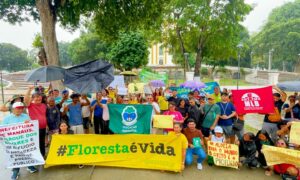Researchers from Instituto Juruá spent 38 days on board, visiting communities to conduct interviews with the residents. In all, 22 communities were visited throughout the Mid Juruá region, with 284 people interviewed between May 18 and June 26 this year.
By Letícia Araújo
Earlier this year, Instituto Juruá launched the River Guardians project to explore the greater aquatic megafauna in the Amazon. This work, spearheaded by National Geographic Explorer and Rolex Laureate João Campos-Silva and as well as Explorer Andressa Scabin is part of the two-year National Geographic and Rolex Perpetual Planet Amazon Expedition which supports a series of scientific research studies and storytelling journey along the entire Amazon River Basin, spanning from the Andes to the Atlantic. As part of the Perpetual Planet Amazon Expedition, Campos-Silva, Scabin and other Instituto Juruá researchers conducted one-on-one interviews with local residents to better understand their relationship with six species of Amazonian aquatic megafauna and investigate whether changes in the populations of these species over time have occurred in the environment.
This project is currently at the historical reconstruction of the megafauna species phase. “At this stage we can also find out how much these people actually know about the place, because we asked when they started going to a certain place and when they stopped going, or if they still do”, explains Gabriela Vedovello, one of the scientists who took part in the expedition. “This way we can get a dimension of whether the person would notice the environmental changes in that place over time or not.”
The interviews with the residents of the regions bring the point of view of those who perceive and closely experience the changes occurring in the environment – an essential perspective to understand this process.
“I realized that my role as a scientist is to give a voice to these people and do what I can so that the rest of the world understands the importance of traditional people and knowledge. These are people with a gigantic intelligence, who know much more than I will ever know about life in the Amazon forest,” adds Gabriela. “For me, modern science makes no sense without the recognition and appreciation of traditional knowledge, and I feel very happy to be part of a project that has this recognition.”

According to Nathália Messina, one of the researchers who supported the coordination of the expedition, the 22 communities visited are distributed between two Conservation Units (UCs), the RDS Uacari and the RESEX Médio Juruá; in addition to an area outside the UCs, which is covered by a fishing agreement. The residents are already familiar with the presence of researchers in the region: the area has several organizations and associations, such as the Instituto Juruá, with constant activities. Even so, the team maintained the routine practice of talking to each community before starting the activities there.
“What we did when we arrived in the community was always to go to the leader’s house and explain what we intended to do in the communities […] then we explained all this at a meeting with members of the community and asked the leader and the community members for permission to visit their homes to conduct the interviews,” explains Lívia Cruz, one of the biologists responsible for the expedition. “Most of them are happy to give interviews and perceive the Institute’s work as being very positive in the region, so this also makes things much easier.”

In addition to producing a rich scientific material, the trip was an opportunity for personal fulfillment for each of the participants. Sayori Minato, a biologist who also took part in the audiovisual recording of the expedition, fulfilled a wish: “The expedition was the fulfillment of a dream. As long as I can remember I used to say that one day I would go to the Amazon, and in my greatest dreams I would be working inside the forest and getting to know the culture and the people of the forest. As a biologist and photographer, being in contact with the riverside communities, listening to their stories and knowledge was very exciting. I know that this experience has changed me and is still reverberating here, it has changed my way of seeing the world, both personally and professionally. I am sure that I will be a better biologist and photographer because of these exchanges.”
Lívia, who visited the forest at a different time of the year, was surprised by the differences in the ecosystem: “On this second expedition, I witnessed the full river and the ebb tide. It was an incredible experience! I was amazed once again and in a new way… the full streams, the açaí bowls, the boat passing through the narrow holes, as if crossing the forest.”






